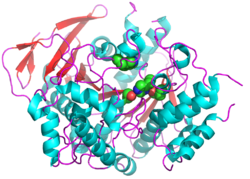User:Joel L. Sussman/Sandbox 2
From Proteopedia
| (4 intermediate revisions not shown.) | |||
| Line 1: | Line 1: | ||
| - | [[Image:HuBChE.png|left| | + | [[Image:HuBChE.png|left|250px]] |
| - | Butyrylcholinesterase (BChE) is an enzyme widely distributed throughout the body in humans, but particularly prevalent in serum, where it occurs as a tetramer of catalytic subunits. It is distinguished from the homologous enzyme, acetylcholinesterase, by its ability to hydrolyze the non-natural substrate butyrylcholine as well as the neurotransmitter, acetylcholine. Its biological role remains obscure, but mutations in the human BCHE gene result in prolonged post-surgical apnea due to the inability of the mutant BChEs to hydrolyse the local anaesthetic, succinylcholine. BChE finds medical use as a bioscavenger for overcoming organophosphate (OP) nerve agent and insecticide intoxication by interacting rapidly with the toxic agents. Crystal structures of both the native enzyme and of its conjugates with nerve agents are available. | + | Butyrylcholinesterase (BChE) is an enzyme widely distributed throughout the body in humans, but particularly prevalent in serum, where it occurs as a tetramer of catalytic subunits. It is distinguished from the homologous enzyme, acetylcholinesterase, by its ability to hydrolyze the non-natural substrate butyrylcholine as well as the neurotransmitter, acetylcholine. Its biological role remains obscure, but mutations in the human BCHE gene result in prolonged post-surgical apnea due to the inability of the mutant BChEs to hydrolyse the local anaesthetic, succinylcholine. BChE finds medical use as a bioscavenger for overcoming organophosphate (OP) nerve agent and insecticide intoxication by interacting rapidly with the toxic agents. Crystal structures of both the native enzyme and of its conjugates with nerve agents are available.<br /> |
<big> | <big> | ||
{{#tree:id=siteTree|openlevels=1|close=top|open=top| | {{#tree:id=siteTree|openlevels=1|close=top|open=top| | ||
* hBChE - Apo human | * hBChE - Apo human | ||
| - | ** [[2pm8]] | + | ** [[2pm8]] |
** [[1p0i]] | ** [[1p0i]] | ||
| - | * BChE+OP irreversible inhibitors, including nerve agents | + | * BChE+OP irreversible inhibitors, including nerve agents and insecticides |
** [[3djy]], [[3dkk]] - hBChE+tabun | ** [[3djy]], [[3dkk]] - hBChE+tabun | ||
| Line 20: | Line 20: | ||
** [[1xlu]] - hBChE+Di-Isopropyl-Phosphoro-Fluoridate (DFP) | ** [[1xlu]] - hBChE+Di-Isopropyl-Phosphoro-Fluoridate (DFP) | ||
| - | * BChE+inhibitor binding at surface of the protein | + | * BChE+inhibitor binding at surface of the protein (far from the active site) |
** [[2j4c]] – hBChE+ HgCl2 | ** [[2j4c]] – hBChE+ HgCl2 | ||
| - | * BChE+substrate analogues mimicking BCh | + | * BChE+substrate analogues mimicking BCh (so as to study the enzyme/substrate complex) |
** [[1p0m]] - hBChE+choline | ** [[1p0m]] - hBChE+choline | ||
** [[1p0p]] - hBChE+butyrylthiocholine | ** [[1p0p]] - hBChE+butyrylthiocholine | ||
| - | |||
| - | |||
}} | }} | ||
</big> | </big> | ||
Current revision
Butyrylcholinesterase (BChE) is an enzyme widely distributed throughout the body in humans, but particularly prevalent in serum, where it occurs as a tetramer of catalytic subunits. It is distinguished from the homologous enzyme, acetylcholinesterase, by its ability to hydrolyze the non-natural substrate butyrylcholine as well as the neurotransmitter, acetylcholine. Its biological role remains obscure, but mutations in the human BCHE gene result in prolonged post-surgical apnea due to the inability of the mutant BChEs to hydrolyse the local anaesthetic, succinylcholine. BChE finds medical use as a bioscavenger for overcoming organophosphate (OP) nerve agent and insecticide intoxication by interacting rapidly with the toxic agents. Crystal structures of both the native enzyme and of its conjugates with nerve agents are available.

